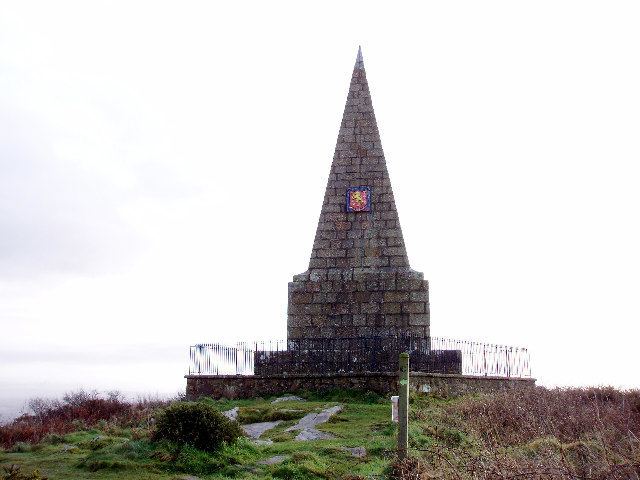Name John Knill | ||
 | ||
Died March 29, 1811, Central London | ||
A quaint quirky quinquennial slice of st ives the 43rd john knill celebrations
John Knill (1 January 1733 – 29 March 1811) born at Callington in Cornwall was a slightly eccentric mayor of St Ives, Cornwall, UK, in 1767 and Collector of Customs at St Ives from 1762–1782. He built his own memorial, a 15-metre (49 ft) high granite obelisk known as Knill's steeple. This obelisk was sited on the summit of Worvas hill (now known as "Knill's Monument", or "The Steeple") with views over St Ives Bay, with the intention that he should be buried in a vault within it, but his body was interred in St Andrew's Church, Holborn. The steeple bears on one side the painted coat of arms of Knill, with the Latin Nil Desperandum (Never Despair); also inscribed on the monument are the words of Johannes Knill 1782, Resurgam (I shall arise), and, in English, I know that my Redeemer liveth.
Contents
- A quaint quirky quinquennial slice of st ives the 43rd john knill celebrations
- John knill monument carbis bay st ives
- Biography
- Legacy
- Notable dates
- References

John knill monument carbis bay st ives
Biography

In 1777 Knill became the private secretary to the newly made Lord Lieutenant of Ireland, John Hobart the Earl of Buckinghamshire; returning to St Ives after six months in the post. A life-time friendship continued and Knill became a trustee of John Hobart's estate when he died in 1793.
Legacy
In his will Knill left money for the upkeep of his obelisk and also £25 for celebrations to take place every five years on St James Day, 25 July. He directed that every five years £10 should be expended on a dinner, and that ten young girls dressed in white should walk in procession with music, from the market house to the monument, around which the whole party was to dance singing the hundredth psalm (All people that on earth do dwell). This quintennial commemoration is made the occasion for a good deal of jollity, in which the entire population joins, indeed the whole proceeding is quite mirth-provoking; nor is the least laughable part of it the looks on the faces of the vicar and mayor, as they sedately waltz around on the upper step of the monument, hand in hand with the ten young girls. The first ceremony, in which Knill himself participated, took place in 1801.
The £25 was to be spent thus:-
It has been surmised that the building of the monument followed a pamphlet Knill allegedly authored castigating the repeated use of consecrated ground for burial, which mirrored a contemporary minor philosophical movement. Certainly, the parish church nearest to Knill's residence (St Ia) has, in modern times, a greatly raised churchyard partly as a result of this practice, being over seven feet higher than the pavements and walkways which lead around it. However, Knill's work and official appointments led him away from St Ives and his intended mausoleum, and his philosophical rapprochement with ecclesiastical interment may or may not have occurred. Knill died at his chambers on 29 March 1811 in Gray's Inn Square London and is buried in St Andrew's Church, Holborn.
Notable dates
The monument on Worvas hill is above the 170-metre (560 ft) contour and is a prominent landmark which vessels off the coast use as a navigation aid.
